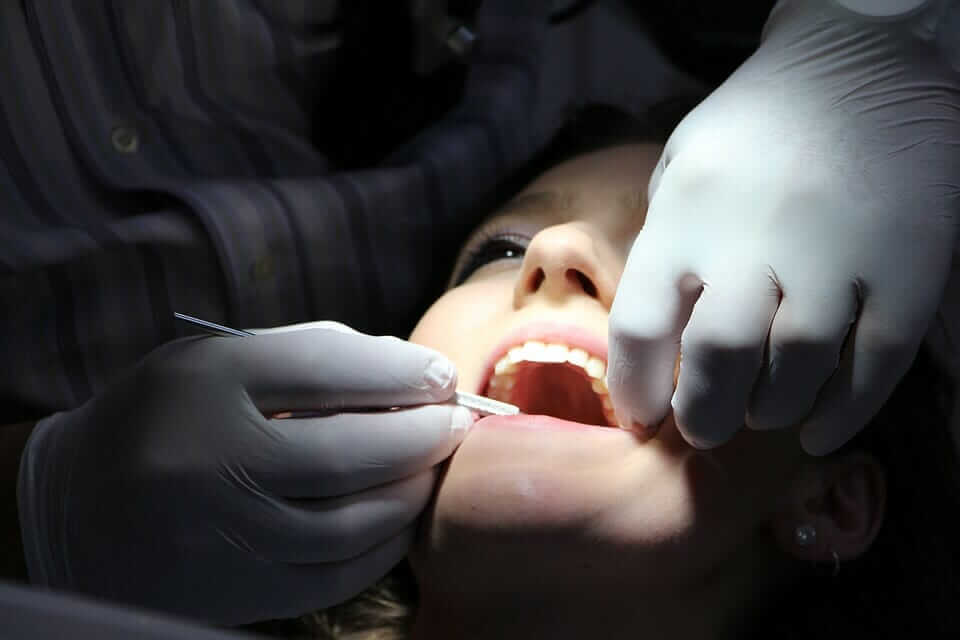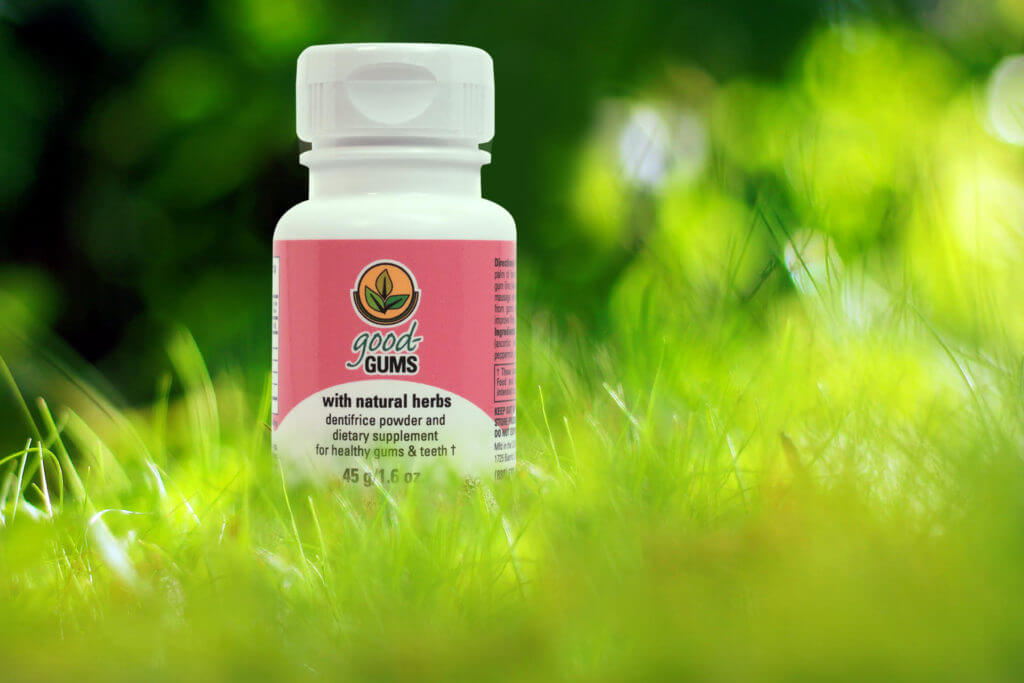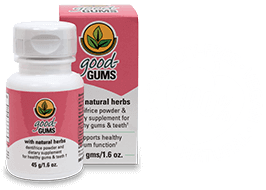Are more and more of your teeth beginning to show, as the gums recede? Are you feeling alarmed and unsure of what to do? Are you avoiding smiling and looking in the mirror, feeling that you look older than your time?
It’s a common condition affecting millions of people, even those conscientious about their health. It’s so common, in fact, that it’s in everyday language; did you know that the phrase ‘long in the tooth’ refers to receding gums?
Don’t worry. Good-Gums is here to help!
The ingredients in Good-Gums are specifically designed to help your body heal itself naturally. A number of users of Good-Gums have taken the trouble to report that large gaps between their teeth have become smaller over time. They can feel more confident, more relaxed and have a greater feeling of control over their oral health, not to mention a fresher, healthier and cleaner feeling mouth! Hurrah!
Irene TThis product is the best thing I have found !! I have receding gums (not too bad, but I notice), bleeding gums, plaque & tartar (when I was young I developed plaque & tartar no matter what I did). I have been using this product & what a difference it makes. I can see my gums are reversing the receding gums, I’m no longer bleeding, the plaque & the tartar are starting to diminish!*
What does it mean to have Receding gums?
If you see that your gum line (where the gums meet the exposed portion of the teeth) has moved away from the end of a tooth and toward its root, you have gum recession. If you see large gaps between the sides of adjacent teeth which once were filled in with gum tissue, that’s also gum recession. Gum recession is essentially the death of enough gum cells to cause a reduction in the volume of gum tissue that previously covered up the tooth toward its root and covered the tooth-supporting structures (e.g., the periodontal ligaments that connect the tooth root to the jaw bone).
Most often gum recession is caused by chronic gum infection, but it could also occasionally be caused by mechanical or chemical irritation of the gums.

But for the vast majority of occurrences, gum infection starts off with bacteria invading gum cells. Plaque-forming bacteria organize into colonies, gathering yeasts and other available materials to form sticky mats of biofilm called plaque, which adhere to the teeth at the gum line. As plaque, the bacterial colonies can flourish, rapidly reproduce, and give off acidic wastes. In little more than a day, the soft plaque starts to crystallize into mineralized, acidic calcifications called tartar (or calculus) that are cemented onto the teeth at the gum line. The gum tissue that constantly touches the acidic tartar can form lesions, through which the bacteria can enter the interior of the gums and infect the gum tissue there. The gum tissue is still alive at this point, with only a few gum cells having fallen casualty, while the body’s immune system gears up to actively attack the invading bacteria. The battle between the immune cells and the invading bacteria is experienced as inflammation. This early stage of gum disease is known as gingivitis.
If the immune system is not successful in eliminating the invading bacteria, then over time the immune system changes tactics from trying to eliminate all the invading bacteria to trying to isolate the infected cells from the rest of the still-healthy cells. This effectively means “amputating” infected cells whose remains are absorbed and then eliminated from the body. When gum cells around a tooth aren’t merely infected but are being killed off, the infection has progressed from gingivitis to periodontal disease. If the infection progresses further along to deeper adjacent cells, it can reach the jawbone and periodontal ligaments that connect the tooth’s root to the jawbone. All of these developments can take place without any pain or discomfort, so that a person might not even be aware of them yet, until the death of these deeper structural cells can lead to recession of the gum tissue closer at the surface. When it progresses further, a tooth will have lost so much structural-connecting tissue that the tooth starts to move when you push on it. Loss of the tooth will have become a real possibility, and it will have become urgent to stop the process of recession and to grow back some of those lost cells.
Iris AIt is now over a year since I began using Good Gums. I had some issues with receding gums and wanted to prevent further erosion. Since I’ve been using Good Gums there is no more recession. The surprising benefit is how clean my teeth and mouth feel.*
While bacterial infection is the root cause of most gum tissue recession, it could also be caused by irritation of the gums, sometimes in conjunction with gum infection, but occasionally on its own. Common mechanical causes of gum recession are grinding, clenching or even clacking your teeth (known as bruxism), which typically happens while you’re asleep or during the day as a nervous habit. Bruxism puts great stress on the periodontal ligaments and jawbone, and may cause cells there to tear away from the tooth, allowing a path for deeper infection. Bruxism can also cause minute cracks in a tooth, allowing bacteria to travel down and infect deeper tissue. Misaligned teeth can put undue force on tooth-supporting structures, leading to their failure and cell death there. While gum recession from mechanical irritation usually starts deep and then affects gums at the surface, recession can come from irritation at the surface, such as from body piercings on the lip or tongue. Brushing aggressively (especially with a toothbrush with hard or medium bristles) might also irritate the gums to the point of recession.
Chemical irritants include tobacco (either from smoking or chewing tobacco), carbonated soft drinks, alcohol, or drugs (both prescribed and recreational). These usually hasten the onset and exacerbation of gum infection, gingivitis and then periodontal disease and gum recession.
Let’s see how Good-Gums can help!
How our combination of SCIENTIFICALLY BACKED ingredients help:
Good-Gums is specifically formulated for gums with clinically proven ingredients of the highest purity and potency. It works with your body’s natural processes, whose predisposition is to heal and nurture. Good-Gums takes advantage of two facts about your gums: their cells have some of the fastest replacement rates in your body, and they are comprised almost entirely of connective tissue. In most of the body a cell lives for an average of 7 to 10 years before being replaced, while a new gum cell is replaced after only 7 to 14 days. Healthier gum cells can start replacing less-healthy cells quickly, if they are given what they need. What new gum cells need is what all connective tissue cells absolutely rely on for their formation: a large amount of vitamin C. Good-Gums is unique in providing a healthy amount of vitamin C, plus citrus bioflavonoids that help the body utilize the vitamin C. Check the labels: other products (whether pastes. balms or essential oils) just don’t provide it. The Good-Gums formula dissolves right in the mouth to be absorbed directly by the gums, where it’s needed the most.
The Good-Gums formula also contains a lot of alkaline baking soda to buffer the acidity of its vitamin C, thereby protecting your enamel from acid erosion. To keep the alkaline baking soda from reacting with the acidic vitamin C in the bottle, the entire formula is kept in a dry powder state. When the powder meets saliva in your mouth, it becomes a liquid solution that starts getting absorbed by the gums immediately before these two ingredients (alkaline and acidic) could react or could weaken the vitamin C.

Good-Gums is absorbed more easily by the inclusion of French grey sea salt in our formula, which has a mineral balance similar to human-produced fluids (so much so, that it was successfully used in place of blood for transfusions to some wounded sailors in WW-II, when blood wasn’t available). This matching mineral composition avoids an ion imbalance that would otherwise stop absorption through cell membranes. Since more of the Good-Gums solution can be absorbed, it can do its work quicker and better.
Besides supporting the growth of healthier new gum cells, Good-Gums also has herbal ingredients that soothe sore gums. Myrrh and peppermint are famous for their soothing properties. Cinnamon is a potent anti-inflammatory. And salt solutions are so soothing as to be the standard recommendation by dentists after oral surgery. All are carefully-selected ingredients of Good-Gums.
To help control the population of the plaque-producing bacteria, peppermint, myrrh, and cinnamon act as natural antimicrobials. Baking soda, besides buffering the acidity of vitamin C, also makes the oral environment less favorable for the proliferation of acid-loving, plaque-producing bacteria.
To help remove plaque from constant contact with the gum margins (where they can re-infect the gums), Good-Gums employs the extraordinary property of cranberry, which significantly loosens the grip of plaque bacteria on the nanoscale, so that it the plaque bacteria can more easily be removed by the mechanical action of toothbrush bristles and floss.
Your gums can improve by the combination of these three strategies: by our unique active nutritional support for the formation of healthier new gum cells, by soothing sore tissue while your gums are recuperating, and by reducing the excessive numbers of and contact by infectious agents.
Try it and see for yourself…

Healthy teeth and gums – for life!
Good-Gums goes to work straight away. Feel the difference as our unique formula – containing everything your gums need to heal and restore – takes effect.
During the first one or two bottles, you are likely to notice a definite improvement to your gums as tissue renews and revitalizes. They may feel firmer and tighter. If your gums had previously been bleeding at times, they probably will have stopped. Previous sore spots may no longer feel sore… all encouraging signs that you’re on the right path.
But that’s just the start…
Our goal for you is to have fully restored, healthy gum tissue firmly attached to your teeth, the elimination of deep gum pockets and no tissue recession, inflammation or irritation, soreness, infection or bleeding – ever again.
And as thousands of customers already know – with Good-Gums it’s possible!
That’s why we recommend that you keep up the good work and continue with an oral care routine featuring Good-Gums for life, so your teeth and gums continue to benefit from our combination of effective natural ingredients.
So invest today in healthy teeth and gums for life with Good-Gums.
Ways to use Good-Gums for receding gums:
It’s critical to grow new healthy gum cells, because recession indicates that many cells from the gum tissue have already been eliminated, and need to be replaced. But in addition to growing new cells, it’s important to stop any further destruction of currently still-existing cells. Stopping further gum recession means eliminating the gum infection and keeping it from recurring. Your immune system is actively at work combating the invading bacteria, but it needs to be relieved from the continual onslaught of additional bacteria that keep invading the gums and that keep overwhelming the body’s defenses.
It’s neither possible nor desirable to eliminate all the bacteria from the mouth. Many of those bacteria are important partners in our breaking down and digesting our own food. But it is important to break up the strongholds created by certain strains of bacteria, where they can organize themselves to propagate and attack teeth and gums. These strongholds are formations of plaque and tartar (dental calculus).

Plaque is a sticky mat of soft biofilm that’s created on the teeth near the gum line by plaque-producing bacteria. The plaque then absorbs mineral ions from the saliva to form calcifications that to become harder than bone and cemented tightly to teeth near the gum line. To be removed, tartar typically requires the use of metal implements by a dental hygienist. Both strongholds (plaque and tartar) become saturated with increased acidity, environments in which the bacteria thrive. The acids irritate the gums to the point of forming lesions and they dissolve tooth enamel to the point of forming cavities (tooth caries). Through these openings (gum lesions and tooth caries), the bacteria invade the underlying tissue.
Getting the tartar removed is a good first step; from then on you can remove plaque on your own, while it is still a soft biofilm. Removing plaque not only removes the base medium needed for tartar to re-form, it reduces the bacteria from an organized colony into disorganized, free-floating and relatively-harmless individual bacteria. Removing plaque should become a habitual daily routine, since plaque can start absorbing minerals and transforming into tartar in little more than a day. The daily plaque-removal routine can use a variety of methods that complement each other.
The mechanical action of applying Good-Gums with a toothbrush loosens plaque and flicks away loosened debris, disrupting plaque that has formed on the gum line at the front and back of the teeth. But applying Good-Gums with a toothbrush also massages the gums at the same time, helping them absorb the herb-and-vitamin formula that supports healthy gum function. Gums are very absorptive when they are bare, but are not as absorptive when they are coated. Because toothpaste contains glycerin which can leave a filmy coating on the gums that seals the gums from absorbing the vitamin and herbal solution, toothpaste should not be used within the four hours before using Good-Gums. Detailed instructions on how to apply Good-Gums come with your shipment.
Here’s How…
APPLYING GOOD-GUMS WITH A TOOTHBRUSH
Our recommended way of applying Good-Gums with a toothbrush loosens plaque and brushes away loosened debris, disrupting plaque that has formed on the outside and inside flat sides of the teeth. But our method also massages the gums at the same time, helping them absorb the herb-and-vitamin formula that supports healthy gum function. Detailed instructions on how to apply Good-Gums most effectively with a toothbrush come with your shipment.
A tooth brush is an essential tool for breaking up plaque on the front (outer) surfaces and also the back (inner) surfaces of teeth. But Good-Gums uses a slightly different technique than brushing with toothpaste. That’s because toothpaste relies on the abrasives in it to grind away plaque, which is somewhat effective at reducing plaque, but which also grinds away molecules from the surface of tooth enamel. But toothpastes fail to provide any direct support to the growth of healthy new gum cells. Good-Gums does support the growth of healthy new gum cells (through its buffered vitamin C), and it’s also effective at removing plaque, but not by any abrasives. Instead Good-gums employs an herbal ingredient that relaxes bacteria’s adhesive grip, so that the toothbrush can more easily remove the plaque.
The Good-Gums technique is to dissolve some Good-gums powder in saliva to form a liquid solution, and then to angle the brush 45-degrees, to slide some of the bristles into the crevice between the gums and the root of a tooth, and then to wiggle the brush head in tiny circles so that the bristles in the crevice move to and fro. This massages the gums for better absorption.
Toothbrushes intended for use with abrasive-laden toothpaste are relatively hard, even when they’re labeled “medium” or “soft; but with Good-Gums we use an “extra-soft” toothbrush. Instead of using a toothbrush to grind abrasive paste into where plaque forms, a toothbrush is used to massage a dissolved solution of Good-Gums into the plaque and into the gums as well; then the brush sweeps away the loosened debris. Electric toothbrushes can be used with Good-Gums; they almost always come with extra soft bristles.
Flossing
Flossing with Good-Gums (if done properly) is a good way to remove plaque from between the teeth, where a toothbrush can’t reach, while also transferring dissolved Good-Gums below the gum line. Proceed very slowly and gently for the first few days, as your gums may be sore and sensitive, or even bleed. Day by day your gums will get a little more resilient. Put a small pinch of Good-Gums in your mouth and swirl it to the first section (e.g., upper left) that you’ll floss. Move the floss between two teeth (do not snap into place). Then position the floss as deeply as you can into the gum line, pull it tightly around one side of the tooth, and scrape from the root toward the crown. Do not use an in-and-out sawing motion. Floss all the way under the gum line, and the dissolved Good-Gums solution will be moved under there as well. Then halfway-wrap the floss around the side of the other tooth and scrape its plaque loose. Remove the floss and move it to the next split between teeth to floss the sides of those two teeth. When one section is done, take another small pinch of Good-Gums and repeat the process.
Interdental brushes
Because gum pockets are an indication of an underlying history of periodontal disease, it’s important to remove as much plaque as possible from the sides of the teeth. A way to remove even more is with an interproximal brush (sometimes called an interdental brush or proxabrush). It’s a small plastic or wire rod with little bristles spiraling around one end of the rod. Put a small pinch of Good-Gums in your mouth, where it will dissolve, swish it to a section of teeth and move the interproximal brush in and out between teeth, using the spiraled bristles to massage the dissolved Good-Gums into the gums. This practice is particularly beneficial for addressing gum tissues that have detached and have formed pockets on the ides of teeth.
Soaking the gums around a troubled spot
A good way to use Good-Gums is to let it sink into the tissues, folds, and crevices of a troubled spot for a longer time than the exposure from the above steps.
• Put a small pinch of Good-Gums into your mouth and let it dissolve.
• Swirl it over any areas of particular concern and hold it to let the liquid cover the problem area.
• Gum tissues do absorb quite readily, so let the Good-Gums stay there for a few minutes.
Supragingival oral irrigation
Oral irrigation is an additional step beyond the toothbrush, floss and interdental brushing. Gum pockets can harbor anaerobic bacteria, which need an airless environment to thrive, and gum pockets provide the necessary airless condition. To help overcome gum pockets, the bacteria should ideally be flushed out regularly. Merely rinsing the mouth (even with Good-Gums) does not provide for much penetration into gum pockets. An oral irrigator will deliver an aqueous solution into periodontal pockets and will penetrate on average to approximately half the depth of the pockets. An oral irrigator has a wand connected to a reservoir with a water pump, such as Hydrofloss, Waterpik or Viajet, that shoots liquid into the gum line and between teeth. Oral irrigators are especially effective for pockets less than 4 mm deep. Put a little Good-Gums in your irrigator’s reservoir to give the water a little boost; rinse the wand with clear water after each use.
Subgingival irrigation
Subgingival irrigation provides a way to flush out gum pockets that are deep, i.e., 5mm or deeper. This is a viable tactic when the measures described above aren’t enough to reduce your gum pockets. A subgingival irrigator is like a regular oral irrigator in that both squirt a liquid solution between the gums and the teeth. A regular oral irrigator uses a nozzle that is held a short distance from the gums and teeth, relying on the water pressure to squirt the liquid into the gum pockets. A subgingival irrigator has a small thin reed-like nozzle with a rounded tip (called a cannula) that is slipped between a tooth and its gums before the liquid is squirted. The pocket is quite effectively flushed out if the tip of a subgingival irrigator is inserted 3 MM (a little less than 1/8 inch) into the pocket. It’s best to use a subgingival irrigator only on very deep pockets, and to know which sides of which teeth have the deep pockets; ask your dentist or dental hygienist for a copy of your “perio chart.” Subgingival tips are available for Hydrofloss irrigators (use the Oral Irrigator Sulcus tips) and for Waterpik (use the Pik Pocket tip) and also for Viajet (use the SulcaSoft tip or the Deep Pocket Irrigation Kit). If you don’t have an oral irrigator machine, you can use a manual subgingival irrigator which is less expensive (such as the Oral Breeze Deep Pocket Irrigator Syringe and Tips or the OraTec Pocket Care Irrigator). Dissolve a little Good-Gums in a regular water glass or bottle before drawing the solution into manual irrigator; rinse it out with clear water after each use.
How to tell that Good-Gums is working:
Typically you learned that your gums were receding by looking at their changing appearance over time in the mirror. This is an external indication of what’s been going on under the surface for a long time. As the gums receded from the front surfaces of the teeth and as portions that once were covered with gums became exposed, you started to look “long in the tooth.” The spaces between teeth that were once filled with gum tissue started to become voids, and then larger voids. When your gums recede, sometimes your teeth become more sensitive to hot or cold, as the gums recede toward the root, beyond where there’s enamel. Sometimes you can feel a notch with your finger where the end of the enamel makes its transition to the exposed dentin, which used to be covered by gum tissue.

When your gums stop receding, you’ll no longer see these conditions worsen. But you’ll be able to tell directly only by watching over several months. You’ll probably want a quicker indication than that, so look for the absence of signs of any periodontal disease or gingivitis. One of the earliest indirect indicators is to look for the reduction in (or even the absence of) plaque and tartar. You can see this by using a chewable disclosing tablet or a liquid disclosing solution after your daily routine with Good-Gums (applying by brush, floss, interdental brush and/or oral irrigation). A disclosing solution is available at drugstores and it reveals any remaining plaque or tartar by staining it with vegetable dye, and then the dye can easily be brushed or scraped away along with any plaque that was missed. This can be an excellent training tool to learn how to remove plaque most effectively. If there is no stain, then there is no plaque or tartar, and there will be no source of additional infection to start at the surface of your gums. No new occurrences of gum infection mean that the growth of additional new gum cells (with the support of Good-Gums) won’t be undermined by unnecessary and avoidable death of gum cells.
How long until you can see results:
The replacement of cells that have died off and that no longer exist takes more time than merely restoring the health of still-intact tissue that is simply inflamed. Gum recession happened slowly, typically over a number of years. Reversal will take a bit of time. But recession can stop getting worse right away, after the underlying causes are removed: periodontal disease, mechanical or chemical irritants, or bruxism (especially at night, which can be addressed by a night guard).
Reversing the effects of gum recession is a slow process. Reversing recession at the front flat surfaces of teeth is the slowest, so slow that it’s hard to notice. Gum tissue growing back in another location, into the gaps between the teeth, is somewhat faster, but the time scale is still over several months if not a few years of feeding the growth of new cells while keeping you tartar-free, gingivitis-free and periodontitis-free. But the first observable indication that new cells have stated growing back is often in the reduction of the depth of deep pockets. Even though it requires measurements by a dental hygienist in order to observe this progress, it is objective evidence that additional new cells are growing and that they are reattaching the gum tissue to the tooth root. A number of Good-Gums customers have contacted us to tell us of their improved gum-pocket measurements after using Good-Gums. They’ve successfully turned the tide on gum recession.
Thank goodness for Good Gums!!
PHIL WIt’s made a big difference in my gum health over the years. My 5s and 6s went down to 3s and 4s; my 3s and 4s down to 1s and 2s*
HOWARD W (not related to Phil W)Other products claim to do the same thing. Yours is superior. It works. My gums have started growing back. It’s unbelievable.*
Want to know more about other common GUM HEALTH ISSUES?



